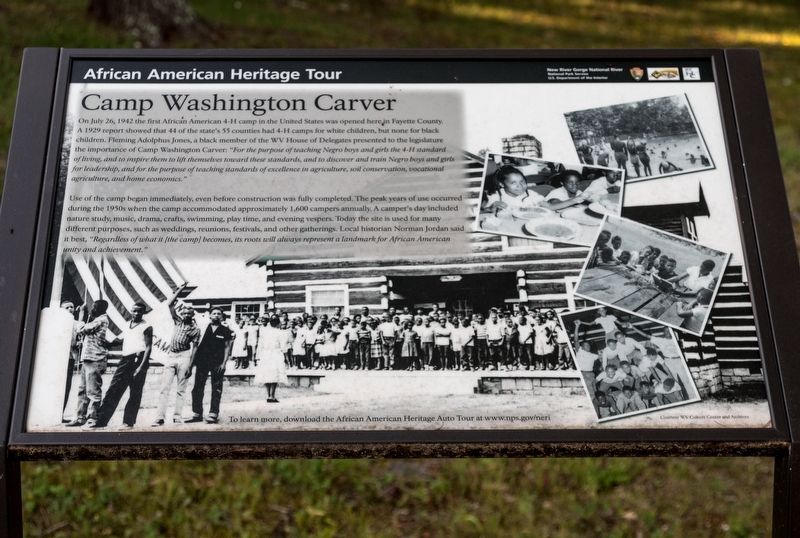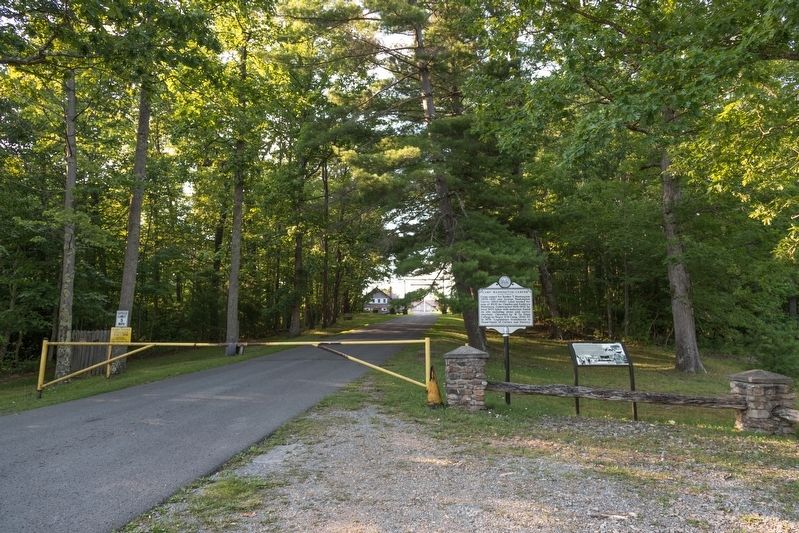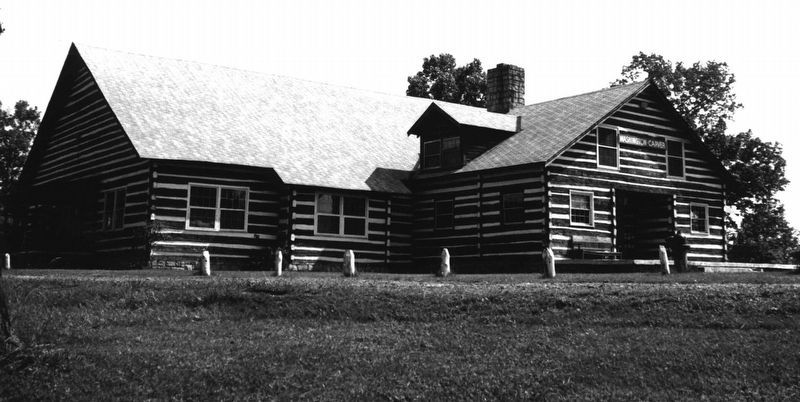Near Clifftop in Fayette County, West Virginia — The American South (Appalachia)
Camp Washington Carver
— African American Heritage Tour —
On July 26, 1942 the first African American 4-H camp in the United States was opened here in Fayette County. A 1929 report showed that 44 of the state’s 55 counties had 4-H camps for white children, hut none for black children. Fleming Adolphus Jones, a black member of the WV House of Delegates presented to the Legislature the importance of Camp Washington Carver: “For the purpose of teaching Negro boys and girls the 4-H standard of living and to inspire them to lift themselves toward these standards, and to discover and train Negro boys and girls for leadership, and for the purpose of teaching standards of excellence in agriculture, soil conservation. Vocational agriculture, and home economics.”
Use of the camp began immediately, even before construction was fully completed. The peak years of use occurred during the 1950s when the camp accommodated approximately 1,600 campers annually. A camper’s day included nature study, music, drama, crafts, swimming, play time, and evening vespers. Today the site is used for many different purposes, such as weddings, reunions, festivals, and other gatherings. Local historian Norman Jordan said it best, “Regardless of what it [the camp] becomes, its roots will always represent a landmark for African American unity and achievement.”
To learn more, download the African American Heritage Tour at www.hps.gov/neri
Topics and series. This historical marker is listed in these topic lists: African Americans • Education • Notable Places • Parks & Recreational Areas. In addition, it is included in the 4-H Youth Program series list. A significant historical date for this entry is July 26, 1942.
Location. 38° 0.462′ N, 80° 58.184′ W. Marker is near Clifftop, West Virginia, in Fayette County. Touch for map. Marker is in this post office area: Danese WV 25831, United States of America. Touch for directions.
Other nearby markers. At least 8 other markers are within 5 miles of this marker, measured as the crow flies. Camp Washington-Carver (a few steps from this marker); Andrew & Charles Lewis March (approx. 3.2 miles away); Spy Rock (approx. 4.3 miles away); Visiting Nuttallburg (approx. 4.3 miles away); Exploring Nuttallburg (approx. 4.6 miles away); Segregated Coal Town (approx. 4.6 miles away); Nuttallburg and Short Creek (approx. 4.7 miles away); A Building Evolves (approx. 4.8 miles away).
Also see . . . Camp Washington Carver Complex - National Register of Historic Places Nomination Form. West Virginia Department of Arts, Culture and History website entry:
Excerpt:
Statement of Significance.(Submitted on August 20, 2019.)
The Camp Washington - Carver complex near Clifftop, Fayette County, West Virginia, is a significant group of major buildings, dependencies, and facilities that has achieved exceptional importance within the past 50 years as the focus of cultural activities and events significant in West Virginia Black history. The complex is equally significant as an unusually well-preserved large-scale project of the Works Progress Administration which combined resources of federal, state, and local agencies with local manpower in the late 1930’s to revitalize segments of the national economy during the Great Depression. Camp Washington - Carver is perhaps best known for its Great Chestnut Lodge, a log building built entirely of West Virginia chestnut. The enormous lodge, with its satellite facilities, is sited on a landscaped grounds at an elevation of 2500 feet above sea level in a remote section of southeastern West Virginia.
Public concern for the development of talents and productivity of blacks in West Virginia before Brown versus Board of Education was centered at West Virginia State College at Institute, at Camp Washington - Carver, an adjunct facility of the extension service division of State College, at Bluefield Institute, and, to a smaller extent, at Storer College in Harpers Ferry. A move to provide the state’s black youth with outdoor educational and recreational facilities developed in the late 1930s in part to take advantage of funding opportunities offered to the State Board of Control (the state agency that sponsored construction of Camp Washington- Carver) by the federal Works Progress Administration, and to establish a complex of the quality offered West Virginia’s white youth at Jackson’s Mill, a 4 - H camp. Legislative authorization of the Camp, and official stipulation that it become a unit of West Virginia State College’s agriculture extension service, resulted when a bill was introduced by Black legislator and attorney Fleming A. Jones, Jr., of Welch (who served in the House of Delegates from McDowell County, 1935-43; 1945-47), and passed by the Legislature March 9, 1937 (Acts and Resolutions of the Forty - Third Legislature of West Virginia - Regular Session, 1937, Chapter 101). Following construction of the Negro 4 - H Camp in the period 1939-42, the Board of Control in its Twelfth Report stated that the facility was “the first of its kind in the entire nation.”
The Negro 4 - H Camp, subsequently named Camp Washington - Carver by West Virginia State College for the great Black leaders, Booker T. Washington (1856-1915) and George Washington Carver (c.1864-1943), was a center serving from 200 to 1600 black youth in areas of vocational agriculture, soil conservation, home economics, and 4 - H standards. Its facilities, including the Great Chestnut Lodge, log cottage, dorms, pond, and grounds form a complex of interrelated structures built of locally fashioned hardwood and native stone to conform to the natural environment. It survives as a well-preserved example of one of West Virginia’s most ambitious WPA projects.
The Great Chestnut Lodge (Assembly and Dining Hall), a mammoth log structure that is the center of the complex, is the largest log building in West Virginia, the largest structure in West Virginia built entirely of chestnut , and contains the Great Hall, the greatest unobstructed enclosed space of any log structure in the state. Because chestnut stands were destroyed throughout the country by uncontrolled blighting in the 1930’s, the materials of the Great Lodge, log cottage, and subsidiary buildings become increasingly valuable as the complex ages.
Camp Washington - Carver was designed by the West Virginia Board of Control as a project of the WPA. Civil engineers J. R. Strock and landscape architect Frank C. Harris played large roles in the actual preparation of designs, plans, and drawings for the facilities. They were assisted in these duties by a number of WPA and Board engineers who reviewed the project and schedules. Several names of prominent project professional personnel included: Cosby Cooke, F. A. Wyant, F. R. Ehrke, Emory A. Hoke, and a Mr. Burgess. The complex was constructed locally available labor (not “convict” labor as has been alleged).
Dedication of the West Virginia Negro 4 - H Campoccurred on July 26, 1942. The ceremony was attended by a host of state dignitaries and featured a major address by Governor M. Mansfield Neely. Other prominent leaders included John W. Davis, president of West Virginia State College, and D.T. Murray, president of the Negro state board of education. The gathering was serenaded by the bands of Garnet and DuBoise High School.
Continued use of the Camp Washington - Carver complex for educational and entertainment purposes was assured in 1979 when ownership of the immediate complex with its 583-acre tract was passed to the West Virginia Department of Culture and History. The Department is presently adapting the facilities for use as a center to interpret and promote West Virginia culture.
Credits. This page was last revised on January 23, 2022. It was originally submitted on August 20, 2019, by J. J. Prats of Powell, Ohio. This page has been viewed 286 times since then and 28 times this year. Photos: 1, 2, 3, 4, 5. submitted on August 20, 2019, by J. J. Prats of Powell, Ohio.




